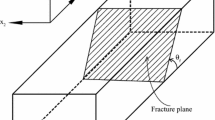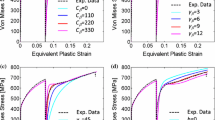Abstract
A model for the ductile fracture process at the tip of an existing crack in a predominantly elastic solid is developed from a theory for ductile fracture by internal necking of cavities. The crack tip displacement and the length of a small elastic-plastic zone at the crack tip are derived from a modification of the Dugdale model for crack tip plastic zones; an approximation to the crack tip stress distribution is derived from Hill's slip-line field solution for a parallel sided crack of finite tip radius. The model provides a relation between the pre-instability strain (or strain hardening exponent), the volume fraction of cavity nucleating second phase particles, the crack tip radius and the critical plane-strain stress intensity factor K IC .
Theoretical estimates of K IC for an SAE 4340 steel correlate closely with experimental K IC values for an assumed value of the effective crack tip radius of 0.0005 ins.
Résumé
En se basant sur une théorie de la rupture ductile par instabilité interne de cavités, on développe un modèle pour décrire le processus de rupture ductile à l'extrémité d'une fissure préexistante dans un solide de caractéristiques essentiellement élastiques.
Le déplacement à l'extrémité de la fissure, et la longueur de la petite zone élasto-plastique en amont de celle-ci, sont déduits d'une modification du modèle de Dugdale décrivant les zones plastiques à l'extrémité d'une fissure. On tire par ailleurs de la solution de Hill pour le champs de lignes de glissement une approximation de la distribution des contraintes à l'extrémité de la fissure, dans le cas d'une fissure à faces parallèles et d'acuité finie.
Le modèle conduit à une relation entre la déformation de pré-instabilité (ou module d'écrouissage), la proportion volumique de particules de seconde phase qui nucléent en cavités, le rayon d'extrémité d'entaille et le facteur critique d'intensité de contrainte en état plan de déformation K IC .
Des estimations théoriques de K IC pour un acier AE 4340 sont en étroite correlation avec les valeurs de K IC expérimentales, dans le cas d'un rayon effectif à fond d'entaille supposé être de 0,005 pouces.
Zusammenfassung
Ausgehend von ciner Theorie des Verformungsbruchs durch interne Unstabilität von Aushöhlungen, wird ein Modell für den Verformungsbruchvorgang an der Spitze eines bestehenden Risses in einem vornehmlich elastischen Festkörper entwickelt. Das Fortschreiten der Rißspitze und die Länge einer kleinen elastisch-elastischen Zone an der Rißspitze werden aus einer Abwandlung des Dugdale-Modells für die elastischen Zonen an der Rißspitze abgeleitet; eine Annäherung der Verteilung der Spannungen an der Rißspitze wird für den Fall cities Risses mit parallelen Flächen und endlicher Öffnung aus Hills Lösung für die Gleitlinienfelder abgeleitet.
Das Modell gibt eine Abhängigkeit zwischen Verformung vor der Instabilität (Verformungshartungsexponent), Volumenanteil der hohlraumbildenden Zweitphasenpartikel, Rißspitzenradius und kritischem Spannungsintensitätsfaktor K IC für plane Verformung.
Theoretische Schätzungen von K IC für einen SAE 4340-Stahl stehen in enger Korrelation mit experimentellen K IC -Werten für einen geschätzten Wert des effektiven Rißspitzenhalbmessers von 0,0005 Zoll.
Similar content being viewed by others
References
G. T. Hahn and A. R. Rosenfield, Applications Related Phenomena in Titanium Alloys, A.S. TM., S.T.P., 432 (1968) 5.
J. M. Krafft, Applied Materials Research, 3 (1964) 88.
P. F. Thomason, J. Inst. Metals, 96 (1968) 360.
R. Hill, J. Mech. Phys. Solids, 5 (1957) 153.
J. M. Alexander, J. Inst. Metals, 93 (1964–65) 366.
H. Ll. D. Pugh, Nat. Eng. Lab. Rep. No. 142 (1964).
E. F. Chandler, Nat. Eng. Lab. Rep. No. 306 (1967).
J. F. Knott and A. H. Cottrell, J. Iron and Steel Inst., 201 (1963) 249.
D. S. Dugdale, J. Mech. Phys. Solids, 8 (1960) 100.
F. M. Burdekin and D. E. W. Stone, J. Strain Anal., 1 (1966) 145.
R. Hill, Selected Government Research Reports, Vol. 6, Strength and Testing of Materials, Part 1, p. 177, H.M.S.O., (1952).
P. F. Thomason, Int. J. Fract. Mech., 6 (1970) 353.
E. A. Steigerwald and G. L. Hanna, Trans. Met. Soc. A.I.M.E., 242 (1968) 320.
J. D. Lubahn and S. Yukawa, Proc. A.S.T.M., 58 (1958) 661.
W. F. Brown, Jr. and J. E. Srawley, Plane Strain Crack Toughness Testing of High Strength Metallic Materials, A.S.T.M.S.T.P., 410 (1966) 48.
R. C. Bates, W. G. Clark and D. M. Moon, Amer. Soc. Test. Mat. S.T.P., 453 (1969) 192.
W. G. Clark and R. C. Bates, Westinghouse Res. Rep. No. 69-1E7-RDAFC-PI, (1969).
F. R. Larson and J. Nunes, Trans. A.S.M., 53 (1961) 663.
G. K. Bhat, Rep. No. T.M.242, Mellon Inst. Ind. Res. Pittsburg, (1964).
E. P. Klier, B. B. Muvdi and G. Sachs, Proc. A.S.T.M., 57 (1957) 715.
M. F. Amateau and E. A. Steigerwald, Quart. Prog. Rep. No. 3, T.RW-ER-5937–2, Thompson Rams Wooldridge Inc. Cleveland, (1964).
G. T. Hahn, B. L. Averbach, W. S. Owen and M. Cohen, Fracture (edited by B. L. Averbach et al.) (1959) p. 91, London, Chapman and Hall.
P. W. Bridgman, Studies in Larqe Plastic Flow and Fracture, McGraw-Hill, London and New York, (1952).
Author information
Authors and Affiliations
Rights and permissions
About this article
Cite this article
Thomason, P.F. A theoretical relation between K IC and basic material properties in ductile metals. Int J Fract 7, 409–419 (1971). https://doi.org/10.1007/BF00189111
Received:
Revised:
Issue Date:
DOI: https://doi.org/10.1007/BF00189111




